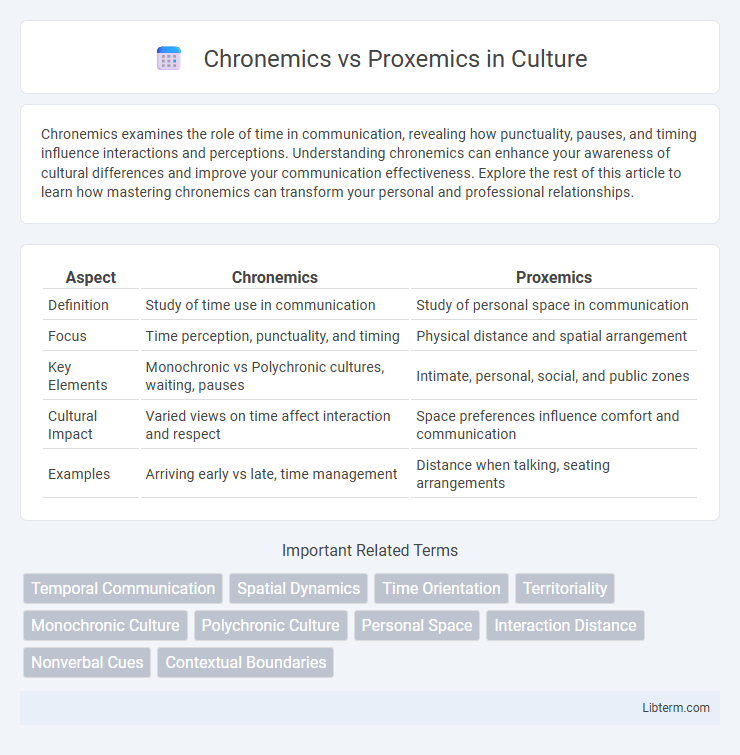Chronemics examines the role of time in communication, revealing how punctuality, pauses, and timing influence interactions and perceptions. Understanding chronemics can enhance your awareness of cultural differences and improve your communication effectiveness. Explore the rest of this article to learn how mastering chronemics can transform your personal and professional relationships.
Table of Comparison
| Aspect | Chronemics | Proxemics |
|---|---|---|
| Definition | Study of time use in communication | Study of personal space in communication |
| Focus | Time perception, punctuality, and timing | Physical distance and spatial arrangement |
| Key Elements | Monochronic vs Polychronic cultures, waiting, pauses | Intimate, personal, social, and public zones |
| Cultural Impact | Varied views on time affect interaction and respect | Space preferences influence comfort and communication |
| Examples | Arriving early vs late, time management | Distance when talking, seating arrangements |
Introduction to Chronemics and Proxemics
Chronemics studies the role of time in communication, analyzing how people perceive and use time to convey messages and regulate interactions. Proxemics examines spatial behavior and how physical distance impacts communication, emphasizing personal space and territoriality. Both fields are essential in understanding nonverbal cues and cultural communication differences.
Defining Chronemics: The Role of Time in Communication
Chronemics explores how time influences communication, encompassing punctuality, waiting, and conversational timing as cultural indicators. It examines how monochronic cultures prioritize schedules and linear time, while polychronic cultures value multitasking and fluid time management. Understanding chronemics helps decode subtle temporal cues that affect interpersonal interactions and social expectations.
Understanding Proxemics: Space and Social Interaction
Proxemics explores how humans use personal space to communicate, categorizing distance into intimate, personal, social, and public zones that influence social interactions and comfort levels. Understanding proxemics reveals cultural variations, with different societies maintaining distinct spatial boundaries affecting communication dynamics and relationship building. Awareness of proxemic cues enhances interpersonal connections by respecting spatial preferences and fostering effective nonverbal communication in diverse social contexts.
Historical Background of Chronemics and Proxemics
Chronemics, the study of time in communication, traces its roots to the work of anthropologist Edward T. Hall in the 1950s, who explored how cultures perceive and structure time differently, influencing social interactions. Proxemics, also introduced by Hall, examines the use of personal space and physical distance in communication, originating from his cross-cultural research on spatial behavior. Both fields have significantly shaped our understanding of nonverbal communication by highlighting culturally specific temporal and spatial norms.
Key Differences Between Chronemics and Proxemics
Chronemics studies the use of time in communication, focusing on how individuals perceive and value time, such as punctuality and response latency. Proxemics examines physical space in interactions, emphasizing personal distance and territoriality between communicators. Key differences include chronemics' emphasis on temporal aspects and time management, whereas proxemics centers on spatial behavior and physical boundaries in social contexts.
Cultural Variations in Chronemics and Proxemics
Chronemics and proxemics reveal significant cultural variations that influence communication patterns worldwide. In chronemics, cultures like the United States value monochronic time, emphasizing punctuality and schedules, while polychronic cultures such as Mexico prioritize relationships over strict adherence to time. Proxemics varies with cultural norms as well; Western societies typically maintain greater personal space, whereas Middle Eastern and Latin American cultures favor closer interpersonal distances, reflecting differing social comfort levels and communication styles.
Impact on Interpersonal Communication
Chronemics, the study of time in communication, influences interpersonal interactions by shaping perceptions of punctuality, response time, and conversational pacing, which can affect trust and relationship dynamics. Proxemics, the study of physical distance between individuals, impacts comfort levels, personal space boundaries, and nonverbal cues that regulate intimacy and social hierarchy. Together, chronemics and proxemics play crucial roles in interpreting messages beyond words, affecting the clarity and effectiveness of interpersonal communication.
Application of Chronemics and Proxemics in Professional Settings
Chronemics influences professional settings by shaping punctuality, time management, and meeting efficiency, where respecting cultural perceptions of time fosters smoother collaborations. Proxemics affects workplace interactions through spatial arrangement and personal space, impacting communication effectiveness and employee comfort in offices or conference rooms. Integrating both chronemics and proxemics enhances organizational dynamics by optimizing scheduling practices and physical layouts to align with diverse cultural expectations.
Chronemics and Proxemics in Digital Communication
Chronemics in digital communication involves the study of time-related behaviors such as response latency, punctuality in virtual meetings, and the timing of message exchanges, which significantly influence perceived politeness and urgency. Proxemics refers to the use of virtual space and digital boundaries, including screen layout, avatar positioning, and the management of personal space in video calls, shaping social distance and relational dynamics. Both chronemics and proxemics are crucial for interpreting non-verbal cues in online interactions and improving communication effectiveness across digital platforms.
Conclusion: Integrating Time and Space in Effective Communication
Integrating chronemics and proxemics reveals the critical role that time and space play in effective communication, influencing perceptions and interpersonal dynamics. Understanding cultural variations in time management and spatial behavior enhances clarity, reduces misunderstandings, and fosters meaningful interactions. Developing awareness of these nonverbal cues supports adaptive communication strategies across diverse social and professional contexts.
Chronemics Infographic

 libterm.com
libterm.com